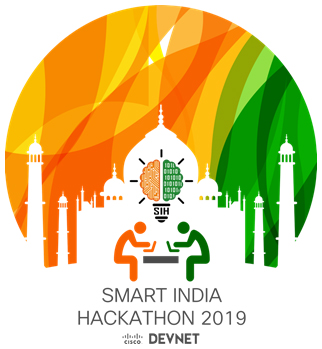Disruptive innovation is changing the way businesses deliver products to customers. The same disruptive innovation is helping countries change the way the country operates and provides various services to its citizens. The Digital India program is a flagship program of the Government of India with a vision to transform India into a digitally empowered society and knowledge economy.

Smart India Hackathon (SIH) is an initiative under the Digital India Program to engage engineering college students to solve problems stated by ministries and from the industry. Students are required to submit idea and prototypes solving various problem statements identified by the government. If the idea is selected, ministries will allow students to develop the product further. Thus, this is mutually beneficial both to students and the government.
For the second year in a row, Cisco DevNet is proud to partner and give back. Our partnership with Persistent Systems for the Smart India Hackathon will help and offer students learning tracks and expert help around Cisco’s industry proven platforms that can be leveraged to solve some of the problem statements. We have dedicated a Smart India Hackathon Site on DevNet that helps and guides these students on using Cisco APIs to solve problems for the government.
Problem Statements
SIH has tried something new this year by allowing corporations to propose problem statements to the students. Cisco DevNet has provided three problem statements:
- Security camera powered with Machine Learning for people detection for queue Data Analytics – The key technical challenge to solve for this problem is to identify people in a specific area. Cisco Meraki camera with MV Sense utilizes a powerful onboard processor to analyze videos and, using Machine Learning algorithms, detects persons in a specific area. Cisco Meraki IoT ready camera can be used as a building block in the student’s application. Students will be able to take a look at current DevNet MV camera projects to jumpstart their development.
- Digital public announcement and chat bot systems – Students will be able to create a tool that can be used to manage public announcements in a physical space, for example:
- Automatically detect people when the user walks into the physical space using Splash screen via WiFi
- Prompt the user to join a support messaging room for that physical location
- Develop a chat bot that can answer frequently asked questions for the location
- Allow the facility administrator to broadcast messages to everyone currently present in the physical space
- Allow the user to have a video call with remote support staff members
- Securing and increasing the productivity of BYOD in classrooms at schools – The key technical challenge to solve for this problem is to build a web portal that could give the ability to teachers to block/filter websites based on student’s names and or classes. You should be able to collect student device and username information via wireless access points and apply some kind of filtering using firewalls.
Along with these problem statements, Cisco DevNet has also created basic and advanced learning journeys to enable students in their mission to be creative!
As we kick off the Smart India Hackathon campaign, we hope it sparks the curiosity of students. In the process, we hope to guide and nurture these students to come up with innovative solutions. Cisco has so many building blocks that they can explore and DevNet has the developer resources for them to explore. If you are a student in India, don’t wait, register to DevNet to access resources and let your journey begin. Remember, your deadline to submit your solution to the Smart India Hackathon (SIH) is January 20, 2019!
As an added element of our dedication to the students in India, Cisco DevNet has partnered with Cisco Meraki for some giveaways as well as additional prizes throughout this journey.
On our page, you will find two related learning tracks (basic and advanced) that explain the API usage related to the problem statements as well as video training materials to assist those who might need some additional help.
Submit your solution today to be part of the drawing.
We’d love to hear what you think. Ask a question or leave a comment below.
And stay connected with Cisco DevNet on social!
Twitter @CiscoDevNet | Facebook | LinkedIn
Visit the new Developer Video Channel

CONNECT WITH US